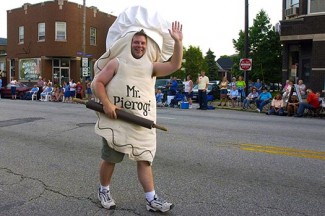
“They were all Irish like Marilyn,” Irene said, laughing, “I was the only Polish girl on that whole trip, and I was the only one to bend over backwards and kiss the Blarney Stone. That was when my back was still good.” Now her back is bent with scoliosis, and although she has a fancy remote-controlled gadget implanted above her hip, she spent most of the time directing the operations of the kitchen from her seat, rising only once when I had fabulously ruined the first batch of dough and the crisis necessitated experienced fingers to patch it up with an appropriate amount of sour cream.
While my own grandmother was Polish (her maiden name was Szmanda, which, Irene told me, is pronounced Schmanda), I had never heard of pierogi until I came to Scranton, a city in northeastern Pennsylvania that sits atop a honeycomb of anthracite mines. The city has magnificent Catholic churches every few blocks, one for each brand of European immigrant who, like Irene’s father, came to work in the coal industry a mile and more beneath our feet. The flavors of those immigrants still perfume the valley.
Rolling dough
The ladies and I made almost 100 pierogi. I learned common tips (mound the sauerkraut and cabbage filling, but make the potato and cheese into more of a log) and old secrets. I rolled dough, and rolled dough, and rolled more dough, until my forearms were tired. From her seat, calmly filling the pierogi shells, Irene assured me that the dough would get better each time I made it. And, true to her prophecy, after I rolled out the third and final batch, Irene patted the dough with her hand and said, “Oh this is perfect,” and she said it with such gentleness, such sincerity, that I felt seven-eighths Szmanda pronounced Schmanda rather than only one-eighth, and I would have happily rolled such perfect dough from that summer afternoon until the next Wigilia.
Irene made me roll the entire third batch of dough for pierogi, even the last pebble that I could not imagine would hold any filling (although she made it work). But the scraps of the first two batches I pushed together, rolled out across the table, and cut with a knife into thin shoelaces in order to make a noodle which Irene and Kathy called haluski. At first I was being meticulous to cut each strip the same length, but Irene and Kathy rushed me. Irene was flouring the strips, and throwing them up and down to keep them from sticking to one another, while Kathy dropped them into the boiling water. “I have to put them in at the same time, so work faster and stop worrying,” Kathy said. “This isn’t pierogi, this is haluski, and it’s not supposed to be perfect.”
“He came to us as food”
The heyday of the coal mine and its laborers and the churches they built in eastern Pennsylvania was all a long time ago, and now most of the mines and many of the churches have been abandoned. But, as I said, the food remains: each summer the cash-strapped churches have festivals, and beside the hamburgers and gravy fries and Texas wieners, the Polish churches will sell their pierogi, the Italians their pizza, and the Irish their potato pancakes. And now at the Nativity church festival, where I first tried a pierogi, they also have a booth where parishioners sell tacos in homemade tortillas and Brazilian tapas.
“It’s earthy stuff,” a priest told me once. We weren’t talking about pierogi, but we might have been. “You have to thirst, you have to hunger. Because He came to us as food, and I think that’s an important mystery.”
I pressed him, saying, “What if I’m sitting in a pew thinking about work, distracted? I’m not particularly hungering for the Eucharist, should I go up to receive?”
“Absolutely,” he said, “because that’s a different question. Now it’s a question of grace. And you never deserve the Eucharist. You go as you are, and not as you think you should be.”
In other words: It is food, and it nourishes us, and that is a mystery, but it’s blue-collar food, the stuff of miners and migrant workers. It’s flour and water, same as pierogi and haluski, or ravioli, or tortillas.
We come to receive the Eucharist carrying everything to the table, all that we mixed in with the extra spoonful of sour cream: the broken backs and the old black lungs, the trying, the forgetting and feeling again the words of our husband, our mother, our siblings alive or long dead. It’s the growing up and falling apart, remembering who we used to be and discovering — all over, or for the first time — who we are.
The post was originally published on August 20, 2012.